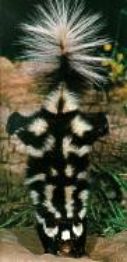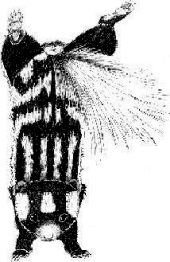

(art by Terry Maxwell)


(art by Terry Maxwell)
Western Spotted Skunk
by
Terry Maxwell
One of the oft-told habits of this species is its response to danger. Spotted skunks stamp the front feet when threatened. If that doesn't work, they do a handstand預 moving handstand用erhaps to present a larger and more threatening appearance. They shuffle forward and backward while handstanding用robably a balancing act. Their last resort is to spray with what is widely considered to be the most obnoxiously scented spray of all skunk species.
The spotted skunks of the genus Spilogale are composed of three species. In a
small corner of southwestern Mexico can be found the diminutive pygmy skunk. The
other two species (western and eastern spotted skunks) have been the subject of
taxonomic debate in the U.S. where they mostly occur.
Some authorities consider western and eastern spotted skunks to be geographic variants (races) of one spotted
skunk species. But they differ in important ways, perhaps most startlingly in a
reproductive quirk of the western one (Spilogale gracilis), found in
western Texas. Western spotted skunks mate in early fall. Pregnancy or gestation lasts about a
month預nd pay careful attention here葉he infants are born in April or May.
Have you been counting months? Yes, well something's wrong then, right? For
about seven months after mating, fertilized eggs don't develop葉hey're delayed
from growing in the uterus. It's called delayed implantation. Eastern spotted
skunks have pregnancies like ours葉hey don't do that delayed thing.
Spotted skunks are the smallest of skunks葉he larger males are about one and
half pounds.
Their white markings are complex, consisting of spots and broken stripes,
bringing us back to that question of rarity of sightings. They are difficult to
see at night. The striking jet black pelage with broken white striping is nearly
impossible to distinguish from moonlight shadows. Apparently because of more
strict nocturnality and preferred shrubby habitat, the animals are seldom
observed by diurnal people.